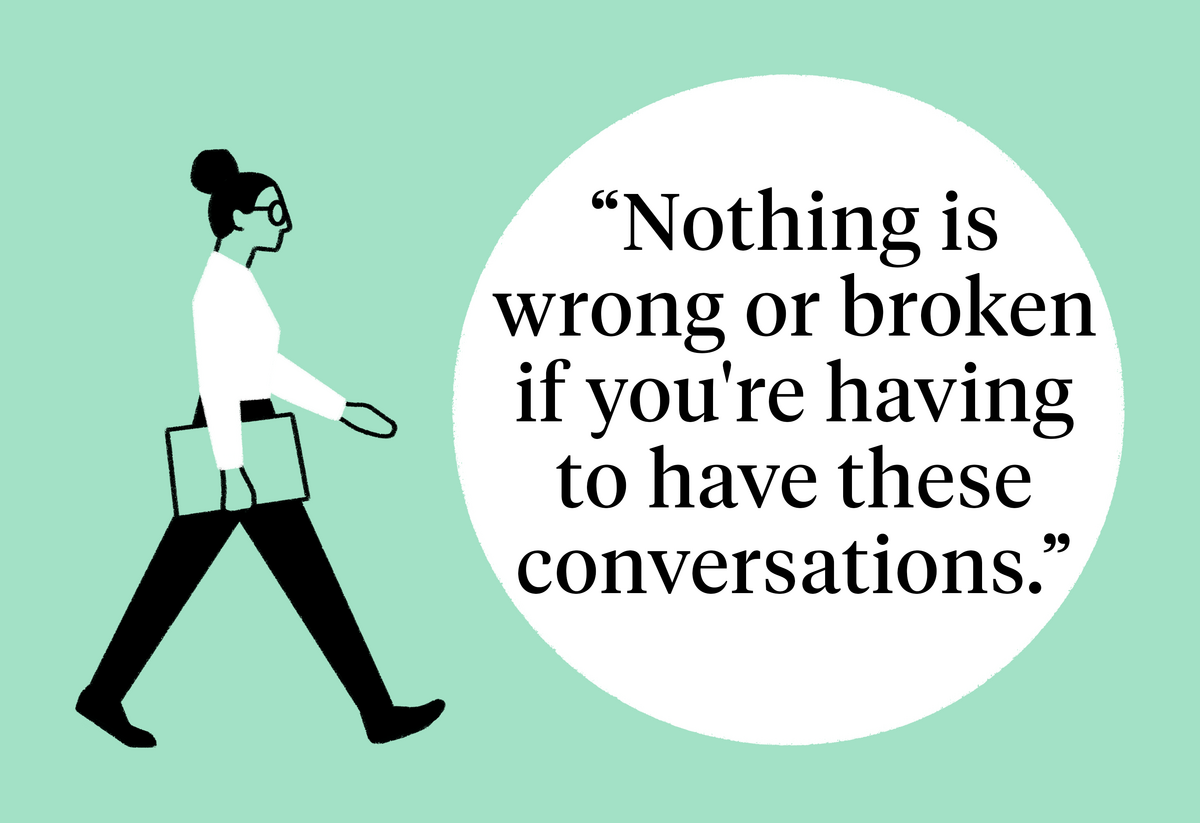Leadership May 18, 2023
Podcast: How to Discuss Poor Performance with Your Employee
Giving negative feedback is not easy, but such critiques can be meaningful for both parties if you use the right roadmap. Get advice on this episode of The Insightful Leader.

“Do you have a second to chat?” is among the most dreaded questions to ask and receive at work because it implies a difficult chat about an employee’s performance is afoot.
No one (hopefully) likes having these conversations, but the ability to do so is an essential leadership skill, says Brooke Vuckovic, a clinical professor of leadership at Kellogg.
“Managerial and conversational courage is the absolute backbone to improving performance, developing talent, aligning expectations, and to solving problems as they arise,” Vuckovic says.
On this episode of The Insightful Leader, Vuckovic shares how to prepare for tough conversations with your team so that you can address problems before they get bigger.
(Also! If you have a second, please take our listener survey: kell.gg/podsurvey)
Podcast Transcript
Laura PAVIN: For leaders, part of your job description is having tough conversations about performance. You know, those “we need to talk” kinds of conversations: maybe one of your employees isn’t hitting deadlines or there is a conflict between some members of your team that’s hurting everyone’s ability to deliver results.
Brooke VUCKOVIC: It comes up in the course of every single leader’s career, meaning the moment that you move from being an individual contributor, you are going to have to have these conversations at some point in time.
PAVIN: That’s Brooke Vuckovic, she’s a clinical professor of leadership at Kellogg and someone who thinks about these “we need to talk” kinds of discussions a lot. She actually coaches executives on how to have these very talks, and she says being able to have these tough conversations with poor performers is an essential leadership skill.
VUCKOVIC: I would go so far as to say that if you are unable to master this skill, and if you are unable to teach it to those that you lead, or to help them to develop it over time, it can be a career derailer. Managerial and conversational courage is the absolute backbone to improving performance, developing talent, aligning expectations, and to solving problems as they arise.
PAVIN: But here’s the thing: nobody likes having these conversations because they can be really uncomfortable. We don’t know how people will react or if the conversation is going to get heated and combative. It’s easy to come up with the worst possible scenarios. But, Vuckovic says that what people don’t consider is the impact of doing nothing.
VUCKOVIC: They underestimate the risk of continuing to delay or to not act. This may be an impact that’s happening to the team, to their own reputation as a leader who possesses the wherewithal to address issues upfront and who is up to the task of having difficult conversations of managing other people.
PAVIN: This is The Insightful Leader. I’m Laura Pavin. Today on the show, we learn how to push through our discomfort and have the tough conversations that create a thriving team and work culture. We’ll hear about how you can prepare for these conversations, strategies for navigating the conversation itself, and advice on how to build trust between you and your team. That’s next.
…
PAVIN: So let’s say, for example, that you’re the leader of a team and you’re running into an issue with one of your direct reports. Maybe they’ve missed the deadline on several assignments or haven’t delivered satisfactory work. You’ve spotted a pattern and know you need to address it. Well, before you actually sit down to talk, Vuckovic has some strategies you can use to prepare. One place you can start is by thinking about the goal for this specific conversation.
VUCKOVIC: And this is important because you wanna understand what are your hopes for this single next conversation.
PAVIN: Those hopes should be for things that are actually in your control. For instance, you DON’T want to go in thinking, “I want my employee to be grateful I raised this issue, to understand it completely, and to change course.” This is not a good goal for a conversation because that’s not at all in your control. People are going to react in different and sometimes unpredictable ways, so better to put your energy toward the things that are within your ability to deliver.
VUCKOVIC: What is in your control are things like: I want to raise the issue with clarity; and I want to invite in their perspective; or I want to raise my perspectives on this particular issue and then schedule a meeting for the next day or two to figure out how we’re gonna address it.
PAVIN: These are goals that you can put your energy towards and actually achieve in the conversation.
Another related tip: don’t expect a full 180 change from one conversation.
VUCKOVIC: Make sure that your goals are very finite and that your expectations for these conversations aren’t high. I hope that you exceed those expectations, but it is far better to go in assuming that you’re gonna make a little bit of progress on an issue—and then you make a ton of progress—than it is hoping that the whole issue is going to be solved and you just get to part A, which often happens. We talk about these conversations as difficult conversations with an ‘s’ for a reason. They often are multiple actions.
PAVIN: Be patient and focus on having this specific conversation knowing that it’s likely going to take a few talks to arrive where you’re trying to go.
Once you’ve decided on your purpose for this single talk, Vuckovic says you should zoom way out to ask some big picture questions, like:
VUCKOVIC: Why have this conversation beyond the issue that you’re addressing?
PAVIN: Ideally, this big-picture purpose—she calls it a “capital P purpose”—would be one that is shared between you and the person you’ll be talking to.
VUCKOVIC: ... if you have a shared purpose like a shared culture or a commitment that you have to a certain outcome that both of you possess, or your hopes for the relationship. And even if you only have a purpose for yourself, which is, “I want to build my capacity to have these conversations, knowing how important it is to leadership in this organization,” that’s okay, too.
PAVIN: If it’s not immediately clear to you what that capital P purpose might be, Vuckovic has some questions that she thinks can help you suss out an answer.
VUCKOVIC: What do you want for you from this conversation? What are you hoping to build? What do you want for the other party that’s involved? What are your hopes for them?
PAVIN: Walking into these conversations with a firm grasp of this larger Purpose has a concrete effect on us as leaders, and on our teams.
VUCKOVIC: They build our ability to think in complex, systematic, interdependent ways with the individuals that we’re engaging with, and that kind of maturation that can come from holding these conversations and managing them well builds that sustained internal capacity for clear-sighted empathy, for perspective-shifting and for change in ourselves and in other people.
…
PAVIN: Alright, so you have set your expectations for this specific conversation at a reasonable level, and you’ve also situated the conversation in its broader context. How else can you prepare yourself for the conversation?
VUCKOVIC: … is to simply count on contrast; to assume—100 percent assume—that there will be data and perspectives that will arise that you did not anticipate in your own preparation.
PAVIN: No matter how much prep you do beforehand or how sure you are about your assessment of the situation, there is almost always other information that you simply could not have known about going in.
Going into the conversation with that mindset will keep you flexible and open to new data being presented, because if you aren’t expecting to learn something new, you might slip into defensive mode. And while it can be hard to prepare for what you don’t know, Vuckovic does have some exercises you can use to anticipate unexpected information.
VUCKOVIC: The first is to reflect in advance of the conversation what things you might not be taking into account. So, for example, you could ask yourself, “What’s my story? How am I interpreting the situation?” And then you swing right back around: “What story might this person be telling about me, or the organization, or the other parties involved?” That’s gonna help you to shift that perspective.
PAVIN: Another thing you can try is to ask yourself what role have you played in facilitating this issue? Like, have you turned a blind eye to something? Or were you unclear in your expectations? Think about what you might have done that could have contributed to the problem.
Trying to see this situation through your team member’s eyes could lead to surprising revelations that may not have occurred to you otherwise and will make you more empathetic when you’re actually in the conversation.
One last thing that can help you prepare for the unknown is this very important question:
VUCKOVIC: “What would change my mind about this situation and the alternatives for solving it?” Simply opening up to your mind, opening up your mind to, “maybe I don’t have this right. Isn’t there any information, data, or perspectives that would arise that would fundamentally cause me to reframe what this situation is?”
PAVIN: We human beings often think we’re right or understand a situation perfectly. Vuckovic says we do actually tend to attribute disparaging qualities to other people to explain their behaviors and downplay other circumstances that might push them to act in a certain way.
Vuckovic thinks we should question our assumptions about what is happening to leave open the possibility for an alternative narrative.
VUCKOVIC: You can challenge this by asking yourself, “Why might a reasonable, rational, and decent person behave in this way?” I’m not saying that they’re reasonable, rational, and decent. They may be, they may not be, but by asking the question, you’re at least opening your mind to other alternatives that may be at play.
…
PAVIN: Up to this point, everything we’ve been talking about has been in preparation for the tough conversation. We covered how to manage your expectations around what you can control in the conversation; we’ve talked about how to nail down a shared goal for the conversation; and we’ve looked at how to keep yourself open to new and contrasting information that could change your perspective.
But now it’s time to get into the conversation itself, and Vuckovic has thoughts on this, too. The main one being that you have to be present throughout the conversation. Pay attention to what the other person is saying.
That may sound self-evident, but it’s harder than you think.
VUCKOVIC: And here’s why: people often spend so much time ginning up their confidence for addressing the issue or thinking about that opening statement and practicing it that they can lose sight of the absolute discipline and rigor and presence that’s required for the rest of the conversation, which is where the learning is going to occur.
PAVIN: It’s easy to get caught up in all the preparation for the conversation that you forget that it’s, well, a conversation! And that means you need to be present to how the person is reacting and responding. So, to keep yourself engaged, Vuckovic recommends telling yourself to wait.
VUCKOVIC: “Wait! Why am I talking? Wait!” You have spent a lot of time preparing for this conversation; your conversation partner has not, necessarily. And so the idea here is to give them time to think, especially if they’re a cold thinker or they’re an internal processor. You may even wanna wait and simply convey your perspectives and then give them time to think about it and circle back later. But at least allowing for enough silence versus filling the silence because of nervous energy.
PAVIN: Giving your conversation partner space to think and speak will likely improve the chances of them staying engaged and actually hearing your feedback. It also makes you slow down and listen not to the words, but the facts, information, and feelings that are being expressed, which, as we addressed in the preparation phase, could be important to shifting your perspective on the situation.
Now, sometimes these conversations can escalate and take a defensive or combative turn. If this happens, Vuckovic likes using a tool that the journalist Amanda Ripley calls “looping.”
VUCKOVIC: So looping takes a couple of steps. The first thing is that you are listening for what’s most important and what that person is saying—so you’re listening for what’s most important. Then you play it back to them, and not repeating it verbatim, but simply as Ripley says, “repeat playing it back to them in the most elegant language you can muster.” So, making them sound as good as you possibly can and then saying, “Did I get that right?”
PAVIN: By restating the information back to them, you’re slowing the conversation down and demonstrating that you care about understanding what they’re saying and giving them a chance to clarify. Ideally, this will allow the person to feel like they’re being heard, and hopefully that will cool down any tensions that might be brewing.
If looping just isn’t cutting it, you may just have to be prepared to pause the conversation altogether.
VUCKOVIC: Have an exit strategy to just have a moment where you decide, “let’s put a pin in this. Let’s think on these two issues.” So you wrap up the conversation on what you need to do, and “let’s pick it up tomorrow.”
PAVIN: Remember, it’s tough conversations with an ‘s’. It’s normal, even expected, that addressing an issue will take some time.
Once the conversation is wrapped up—whether you made huge strides or just a bit of progress—make sure everyone is in agreement about the next steps, and follow up to ensure those next steps actually happen. This builds trust with your employee and help reinforce what were hopefully productive takeaways from the conversation.
…
PAVIN: Look, I get it: it’s not fun having tough conversations in the workplace. But, as Vuckovic points out, they are an inevitable and necessary part of being a leader.
VUCKOVIC: These conversations are part and parcel of working well with human beings—messy human beings—in complex organizations.
PAVIN: So, stop thinking about these conversations as signifying failure.
VUCKOVIC: Nothing is wrong or broken if you’re having to have these conversations. On the contrary, it means you’re on the right path of making sure that you have clarity.
PAVIN: Whatever you do, don’t run away from them. Even though it may be tempting to push them off and pretend they don’t need to happen, you have to step up and be okay with a little discomfort. And the more you have these conversations, the better you get, which is good for you as a leader and for your team.
VUCKOVIC: If you become skilled at them, and if you continue to raise the level of skill of your people, it is a huge professional asset, and it is a huge personal asset. Your teams, your organizations, our communities, our families will all develop and mature the more we’re able to address issues with candor. And my stance is that human relationships thrive—they thrive rather than wilt—when we tend to those relationships with candor and with clarity.
CREDITS
PAVIN: This episode of The Insightful Leader was written, produced, and mixed by Andrew Meriwether. It was produced and edited by Laura Pavin, Jessica Love, Emily Stone, Fred Schmalz, Maja Kos, and Blake Goble. Special thanks to Brooke Vuckovic. Want more The Insightful Leader episodes? You can find us on iTunes, Spotify, or our website: insight.kellogg.northwestern.edu. We’ll be back in a couple weeks with another episode of The Insightful Leader Podcast.


